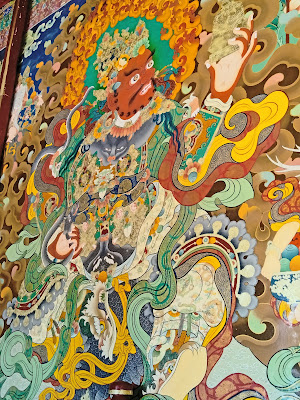 |
| Before Jokhang Temple, we were dropped off by this lamp post, in order to walk through a local section of the Bharkor Bazaar, the commercial district around the temple |
 |
| Clothing store |
 |
| Metalware |
 |
| Yak butter, which seems to mostly to be used as donations in temples to fuel the many yak butter lamps |
 |
| Bakery |
 |
| Produce |
 |
| Butcher with yak meat; only male animals are killed for the meat as the females provide so much more; in Tibet, yak is the male and dri is the female |
 |
| Dried yak meat/jerky |
 |
| Snack shop; we do not know what the horned containers contain (top left) |
 |
| Personal prayer wheels use the dangling weight to rotate the wheel clockwise |
 |
| Embroidered boots |
 |
| Prayer flags are mostly bundled up; they are printed with auspicious symbols, prayers, invocations, and mantras, and are also called "Wind Horses" that spread goodwill to all beings |
Another version illustrates how the animals helped each other to eat from the tree as it grew.
In the center are a pig, a rooster, and a snake, representing the three poisons and causes of suffering, being ignorance, greed, and hatred. The circle that is half white and half black shows virtuous and non-virtuous actions that represent karma. The main circle illustrates the six realms into which one can be reincarnated: at the top are the deva/gods, to their left are the asura/demi-gods, and to the right are manusa/humans. Continuing clockwise from the humans are the tiryak/animals, the naraka/deizens of hell, and the preta/hungry ghosts.
 |
| Pat P liked to insert himself into the photos of others |
 |
| A questioner is about to slap/clap his hand |
 |
| Buddhist Wheel of Life, a visual representation of the Buddhist belief in the cycle of life, death, and rebirth |
The outer circle has 12 allegorical representations of conditions that are interdependent and linked as a chain. Basically, these conditions are 1) ignorance, 2) volitional actions and thoughts, 3) consciousness through interaction of the senses, 4) combination of thoughts and senses, body and mind,, 5) the sense organs, 6) contact where the senses and consciousness result in perceptions, 7) feelings, 8) cravings, 9) clinging or attachment to material things, 10) actions driven by craving and clinging result in becoming, 11) birth or rebirth, 12) aging and death. The only condition that is not interdependent is nirvana, which is not seen in the above photo in the top left corner.
The wheel is held by Yama, the god of death, who symbolizes impermanence.
 |
| Virūpākṣa, Guardian King of the west; here he holds a serpent and a stupa (KSS) |
 |
| Dhṛtarāṣṭra, Guardian King of the east playing a pipa instrument |
 |
| Veranda of the main assembly hall |
 |
| Broom made with twiggy branches |
 |
| Local guide Yudon with a Buddhist nun who is twirling her prayer wheel and holding her prayer beads |
 |
| Back at the hotel we had a presentation by a thangka painter, interpreted by Yudon |
 |
| Thangka (painting on cloth) of a Mantra Mandala, with the words of the mantra (a word or sound repeated to aid concentration in meditation) written clockwise in a circle |







No comments:
Post a Comment